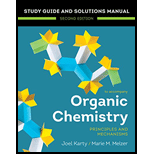
Concept explainers
(a)
Interpretation:
The structure of
Concept introduction:
The root name of any given IUPAC name of the compound shows how many carbon atoms are present in the longest chain that contains the highest priority functional group. The suffix gives the name with the position of the highest priority functional group. The prefix tells the position and names of the substituents (or other lower priority
(b)
Interpretation:
The structure of
Concept introduction:
The root name of any given IUPAC name of the compound shows how many carbon atoms are present in the longest chain that contains the highest priority functional group. The suffix gives the name with the position of the highest priority functional group. The prefix tells the position and names of substituents (or other lower priority functional groups) which are attached to the parent chain. An R or S designation at the start specifies the absolute configuration of any chiral centers present. Similarly, an E or Z designation specifies the stereochemistry of a double bond.
(c)
Interpretation:
The structure of
Concept introduction:
The root name of any given IUPAC name of a compound shows how many carbon atoms are present in the longest chain that contains the highest priority functional group. The suffix tells the name with the position of highest priority functional group. The prefix tells the position and names of the substituents (or other lower priority functional groups) which are attached to the parent chain. An R or S designation at the start specifies the absolute configuration of any chiral centers present. Similarly, an E or Z designation specifies the stereochemistry of a double bond.
(d)
Interpretation:
The structure of
Concept introduction:
The root name of any given IUPAC name of the compound shows how many carbon atoms are present in the longest chain that contains the highest priority functional group. The suffix gives the name with the position of the highest priority functional group. The prefix tells the position and names of the substituents (or other lower priority functional groups) which are attached to the parent chain. An R or S designation at the start specifies the absolute configuration of any chiral centers present. Similarly, an E or Z designation specifies the stereochemistry of a double bond.
Want to see the full answer?
Check out a sample textbook solution
Chapter F Solutions
Organic Chemistry: Principles And Mechanisms: Study Guide/solutions Manual (second)
- Give a clear handwritten answer...complete the following reactions...please give answer all reactionsarrow_forwardGive a clear handwritten answer...complete the following reactions...give answer all sub parts..arrow_forwardWrite reactions of 2-oxopropanoic acid with the following reagents: a. KOH; b. HCN;arrow_forward
- Determine if the following compounds are aromatic or anti-aromatic _N- -N. + (A.) (В.) (C.) (D.) (E.)arrow_forwardGive a clear handwritten answer...complete the reactions with detailed answer..arrow_forwarda. .14. Predict the major product of the following reaction sequence. منا. Br OH 1. CH3OH, H3O+ 2. NaOCH 3. NaOH 4. H3O+ OH منذ للام OH ? لللا e. سلامarrow_forward
- A. Cyclopropenyl cation is unusually stable (EXPLAIN).arrow_forwardCompare and contrast the physical and chemical properties of: propan-1-ol and propan-2-ol; . (E)-butenedioic acid (fumaric acid) and (Z)-butenedoic acid (maleic acid).arrow_forwardGive a clear handwritten answer with explanation..Complete the following reactions?arrow_forward
- c) Rank the following compounds in order of increasing reactivity toward nucleophiles. Explain your reasoning briefly with reference to structural features. or wy CI Aarrow_forward.4 D.3 QUESTION 20 As learned in the synthesis of 1-bromo-3-chloro-5-iodobenzene, electron donating groups enhance the reactivity of benzene towards electrophiles, and electron withdrawing groups decrease the reactivity of benzene towards electrophiles. Based on this, which of the following benzene derivatives is the LEAST REACTIVE towards electrophiles? NO2 NH2 O A. 3 O B. 4 OC 1 O D.2 Click Save and Submit to save and submit. Click Save All Answers to save all ansurers. e here to search Esc #3 8. 3. 4. R IT Q Tab G H CapsLk V B N M C Shift Alt この 7arrow_forwardGive detailed Solution with explanation needed..identify reagents that complete the reactionarrow_forward
 ChemistryChemistryISBN:9781305957404Author:Steven S. Zumdahl, Susan A. Zumdahl, Donald J. DeCostePublisher:Cengage Learning
ChemistryChemistryISBN:9781305957404Author:Steven S. Zumdahl, Susan A. Zumdahl, Donald J. DeCostePublisher:Cengage Learning ChemistryChemistryISBN:9781259911156Author:Raymond Chang Dr., Jason Overby ProfessorPublisher:McGraw-Hill Education
ChemistryChemistryISBN:9781259911156Author:Raymond Chang Dr., Jason Overby ProfessorPublisher:McGraw-Hill Education Principles of Instrumental AnalysisChemistryISBN:9781305577213Author:Douglas A. Skoog, F. James Holler, Stanley R. CrouchPublisher:Cengage Learning
Principles of Instrumental AnalysisChemistryISBN:9781305577213Author:Douglas A. Skoog, F. James Holler, Stanley R. CrouchPublisher:Cengage Learning Organic ChemistryChemistryISBN:9780078021558Author:Janice Gorzynski Smith Dr.Publisher:McGraw-Hill Education
Organic ChemistryChemistryISBN:9780078021558Author:Janice Gorzynski Smith Dr.Publisher:McGraw-Hill Education Chemistry: Principles and ReactionsChemistryISBN:9781305079373Author:William L. Masterton, Cecile N. HurleyPublisher:Cengage Learning
Chemistry: Principles and ReactionsChemistryISBN:9781305079373Author:William L. Masterton, Cecile N. HurleyPublisher:Cengage Learning Elementary Principles of Chemical Processes, Bind...ChemistryISBN:9781118431221Author:Richard M. Felder, Ronald W. Rousseau, Lisa G. BullardPublisher:WILEY
Elementary Principles of Chemical Processes, Bind...ChemistryISBN:9781118431221Author:Richard M. Felder, Ronald W. Rousseau, Lisa G. BullardPublisher:WILEY





